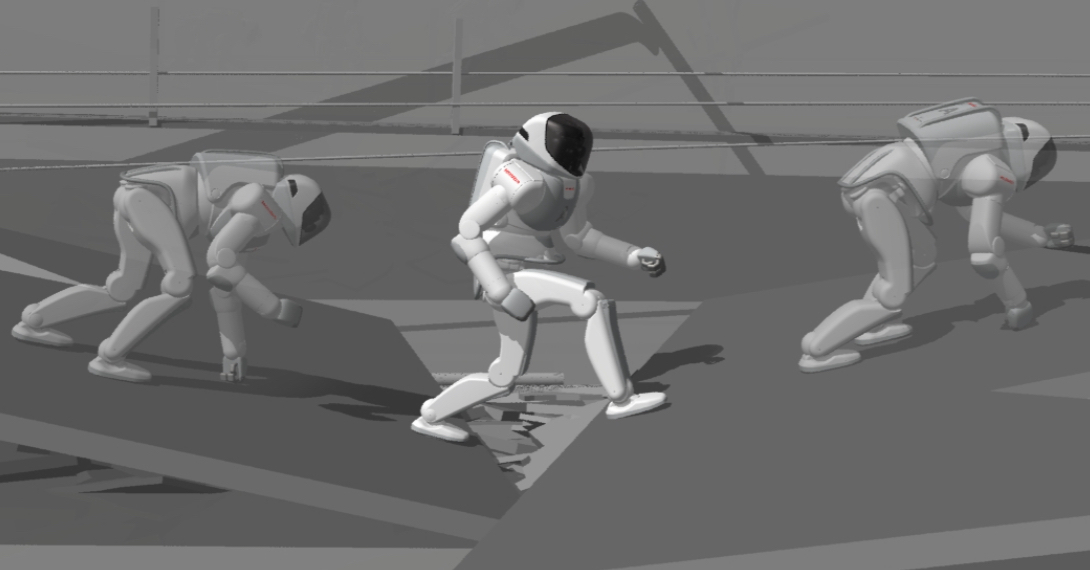Episodes

2 hours ago
2 hours ago
Abonnez-vous à la newsletter Parlons Futur ici : https://www.parlonsfutur.com/
Une fois par semaine au plus, une sélection de news, mêlant sources anglophones et francophones, résumées en bullet points sur des sujets tech 🤖, science 🔬, éco 💰, géopolitique 🌏 et défense ⚔️ pour mieux appréhender le futur 🔮.

Friday Jun 20, 2025
Friday Jun 20, 2025
- What about the risk to contaminate Mars with Earth life and hence muddle the search for indigenous life? Shouldn't we keep Mars pristine for our robots only for now?
- Fermi paradox: is there a Great Filter preventing ET from colonizing the galaxy? Is it behind us or in front of us as for our own species?
- And also: Space war; does he think we'll get AGI and its impact on space exploration ; his Saturn Express plan ; his solution to fix climate change ; the opportunity of a giant array of telescopes on our moon to map Earthlike planets in nearby stars
I'm Thomas Jestin, you can subscribe to my newsletter here:
In English: https://futureweekly2050.substack
In French: https://parlonsfutur.substack.com/

Thursday Jun 12, 2025
Thursday Jun 12, 2025
1. The 3 most cited AI researchers of all time (Geoffrey Hinton, Yoshua Bengio, Ilya Sutskever) are vocally concerned about this. One of them believes the risk of extinction is higher than 50%.
2. The CEOs of the 4 leading AI companies have all acknowledged this risk as real. “Development of superhuman machine intelligence is probably the greatest threat to the continued existence of humanity”
-Sam Altman, CEO of OpenAI “I think there's some chance that it will end humanity. I probably agree with Geoff Hinton that it's about 10% or 20% or something like that.”
-Elon Musk, CEO of xAI “I think at the extreme end is the Nick Bostrom style of fear that an AGI could destroy humanity. I can’t see any reason in principle why that couldn’t happen.”
-Dario Amodei, CEO of Anthropic “We need to be working now, yesterday, on those problems, no matter what the probability is, because it’s definitely non-zero.”
-Demis Hassabis, CEO of Google DeepMind 3. Half of surveyed AI researchers believe that there are double-digit odds of extinction https://x.com/HumanHarlan/status/1925015874840543653

Thursday May 08, 2025
Contre-intuitif : pourquoi l'intelligence humaine baisse en fait depuis 10,000 ans
Thursday May 08, 2025
Thursday May 08, 2025
(désolé pour les petits problèmes de son de temps à autres, notamment de la 12ème à 13ème minute)
Dans cet épisode :
00:58 : Les 5 grands types d'intelligence
05:38 : Comment Homo sapiens est devenu aussi intelligent
11:03 : Pourquoi l'intelligence individuelle des êtres humains décroît depuis 10,000 ans (avec une exception au XXème siècle)
16:05 : Intelligence individuelle vs intelligence collective de l'humanité
19:15 : Qu'est-ce que l'intelligence ? Comment la mesurer ? Plusieurs définitions. 21:20 : Comment les animaux peuvent être plus "intelligents" que nous sur certaines dimensions de l'intelligence : partage d'exemples bluffants !
26:08 : Explication de cette exception de la remontée de l'intelligence au XXème siècle : l'effet Flynn, retour sur ses causes
33:30 : Pourquoi l''intelligence individuelle "brute" semble-t-elle baisser à nouveau depuis 30 ans ?
43:35 : Rôle de la génétique : qu'est-ce qui est le plus corrélé quand mesuré à l'âge adulte : l'intelligence de deux jumeaux séparés à la naissance ? Ou celle de deux personnes sans lien génétique mais élevées ensemble par les mêmes parents ?
Abonnez-vous à la newsletter Parlons Futur ici : https://www.parlonsfutur.com/
Une fois par semaine au plus, une sélection de news, mêlant sources anglophones et francophones, résumées en bullet points sur des sujets tech 🤖, science 🔬, éco 💰, géopolitique 🌏 et défense ⚔️ pour mieux appréhender le futur 🔮.

Friday Apr 11, 2025
Friday Apr 11, 2025
Conversation avec Nicolas Descoqs, fund manager chez Clartan Associés, expert défense et polytechnicien https://www.linkedin.com/in/nicolas-descoqs-a712b62/
Sujets abordés:
- Ukraine vs Russie
- Taiwan / théâtre de la Mer de Chine et du Pacifique
- évolutions de l'art de la guerre : drones, IA, tanks, artillerie.
- Défense française et européenne
Abonnez-vous à la newsletter Parlons Futur ici : https://www.parlonsfutur.com/
Une fois par semaine au plus, une sélection de news, mêlant sources anglophones et francophones, résumées en bullet points sur des sujets tech 🤖, science 🔬, éco 💰, géopolitique 🌏 et défense ⚔️ pour mieux appréhender le futur 🔮.

Wednesday Mar 26, 2025
100 ans de progrès compressés en 10 ans ? Le débat qui agite la haute sphère de l'IA
Wednesday Mar 26, 2025
Wednesday Mar 26, 2025
Débat opposant à distance Dario Amodei, cofondateur d'Anthropic AI, et Thomas Wolf, cofondateur français d'Hugging Face.
Thomas a écrit :
"The "compressed 21st century" comes from Dario's "Machine of Loving Grace" and if you haven’t read it, you probably should, it’s a noteworthy essay. In a nutshell the paper claims that, over a year or two, we’ll have a "country of Einsteins sitting in a data center”, and it will result in a compressed 21st century during which all the scientific discoveries of the 21st century will happen in the span of only 5-10 years.
I read this essay twice. The first time I was totally amazed: AI will change everything in science in 5 years, I thought! A few days later I came back to it and while re-reading I realized that much of it seemed like wishful thinking."
L'essai en question de Dario Amodei : https://darioamodei.com/machines-of-loving-grace
La réplique de Thomas Wolf : https://thomwolf.io/blog/scientific-ai.html
Abonnez-vous à la newsletter Parlons Futur ici : https://www.parlonsfutur.com/
Une fois par semaine au plus, une sélection de news, mêlant sources anglophones et francophones, résumées en bullet points sur des sujets tech 🤖, science 🔬, éco 💰, géopolitique 🌏 et défense ⚔️ pour mieux appréhender le futur 🔮.

Monday Mar 17, 2025
Monday Mar 17, 2025
Source du cas d'usage présenté : https://x.com/WesRothMoney/status/1898982221589172664
Découvert dans l'article du JDN https://www.journaldunet.com/intelligence-artificielle/1539893-manus-l-ia-chinoise-autonome-qui-fait-tout-ou-presque-a-votre-place/
Abonnez-vous à la newsletter Parlons Futur ici : https://www.parlonsfutur.com/
Une fois par semaine au plus, une sélection de news, mêlant sources anglophones et francophones, résumées en bullet points sur des sujets tech 🤖, science 🔬, éco 💰, géopolitique 🌏 et défense ⚔️ pour mieux appréhender le futur 🔮.

Thursday Mar 06, 2025
Thursday Mar 06, 2025
Philippe Bihouix est ingénieur, il s'est fait connaître au travers de différents livres, notamment "L'Âge des low tech : Vers une civilisation techniquement soutenable".
https://www.seuil.com/ouvrage/l-age-des-low-tech-philippe-bihouix/9782021160727
Il publie dernièrement une BD avec le dessinateur Vincent Perriot intitulée "Ressources : Un défi pour l'humanité", aux éditions Casterman https://www.casterman.com/Bande-dessinee/Catalogue/ressources/9782203275980
Nous discutons du message de sa BD et de la question de savoir si un monde d'abondance technologique est possible ou non au 21ème siècle.
Abonnez-vous à la newsletter Parlons Futur ici : https://www.parlonsfutur.com/
Une fois par semaine au plus, une sélection de news, mêlant sources anglophones et francophones, résumées en bullet points sur des sujets tech 🤖, science 🔬, éco 💰, géopolitique 🌏 et défense ⚔️ pour mieux appréhender le futur 🔮.

Wednesday Jan 29, 2025
Wednesday Jan 29, 2025
Qu'est-ce que la fulgurante irruption de Deepseek sur la scène IA nous dit sur :
- la rivalité Chine / Etats-Unis ?
- la dualité open-source / outils propriétaires fermés
- quel impact sur les startups plus largement ?
- quel impact sur les géants de la techs ?
- quel impact sur les clouds providers ?
- quel impact sur OpenAI et Anthropic ?
- quel impact sur Nvidia ?
- quid de la France et de Mistral, Kyutai ?quid des risques si l'on met au point l'AGI ?
Abonnez-vous à la newsletter Parlons Futur ici : https://www.parlonsfutur.com/
Une fois par semaine au plus, une sélection de news, mêlant sources anglophones et francophones, résumées en bullet points sur des sujets tech 🤖, science 🔬, éco 💰, géopolitique 🌏 et défense ⚔️ pour mieux appréhender le futur 🔮.

Wednesday Dec 18, 2024
Amazon et ses 750,000 robots dystopie ou la clef vers un monde d'abondance
Wednesday Dec 18, 2024
Wednesday Dec 18, 2024
Abonnez-vous à la newsletter Parlons Futur ici : https://www.parlonsfutur.com/
Une fois par semaine au plus, une sélection de news, mêlant sources anglophones et francophones, résumées en bullet points sur des sujets tech 🤖, science 🔬, éco 💰, géopolitique 🌏 et défense ⚔️ pour mieux appréhender le futur 🔮.

